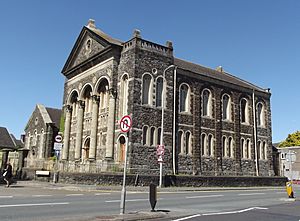Tabernacle Chapel, Llanelli facts for kids
Quick facts for kids Tabernacle Chapel, Llanelli |
|
|---|---|
 |
|
| Location | 17 Cowell Street, Llanelli |
| Country | Wales, United Kingdom |
| Denomination | Independent |
| History | |
| Founded | 1872 |
| Architecture | |
| Heritage designation | Grade II* |
| Designated | 3 December 1992 |
| Architectural type | Chapel |
Tabernacle Chapel is a historic church building in Llanelli, a town in Carmarthenshire, Wales. It was built in 1872 and is located on Cowell Street. This chapel is a very special building, recognized as a Grade II* site. This means it's considered an important historical and architectural landmark.
The chapel was built when Llanelli was growing fast. Many people moved there for jobs in tinplate and steel factories. More places were needed for people to worship. John Humphrey designed the chapel. Its front looks like an ancient temple. It has arches and a grand entrance. The style mixes ideas from Roman, Greek, and other old building designs. Inside, the roof has cool curved patterns. There's also a curved balcony and a fancy wooden pulpit. An organ was added in 1901 by a company called Vowles.
The chapel became a Grade II* listed building on December 3, 1992. It was recognized for its unique design by John Humphrey. It's thought to be the most detailed chapel in Llanelli. The special status also includes the iron fences and gates outside. The Royal Commission on the Ancient and Historical Monuments of Wales keeps records about the chapel. These include many photos and historical details.
Contents
Why Tabernacle Chapel Was Built
Tabernacle Chapel was started because another church, Capel Als, became too small. Too many people wanted to attend services there. The minister, Thomas Johns, noticed many members lived in the western part of Llanelli. So, they decided to build a new church closer to their homes.
The first stone for the chapel was laid on Good Friday in 1873. The land was given by Sir John Stepney MP. The chapel officially opened two years later on Easter Sunday. Thomas Johns preached the very first sermon. By the end of that year, Tabernacle Chapel had 502 members.
Early Leaders of the Chapel
John Ossian Davies became the minister in 1876. He stayed for four years before moving to Swansea. After him, J. Pandy Williams became the minister. His time at the chapel had some disagreements. These included a dispute at Bala Theological College. Because of these issues, two other chapels, Ebenezer and Lloyd Street, were started by people who left Tabernacle.
The next minister was Wynne Evans. He led the chapel for ten years. His time was much more peaceful than the previous minister's. A local newspaper noted that three ministers in a row had left Tabernacle for churches in England.
Gwylfa Roberts: A Poet and Minister
Gwylfa Roberts, a famous poet, became the minister in 1899. He stayed until he passed away in 1935. In 1914, he received a special award from the University of Washington in America. This was for his important work in Welsh literature.
Gwylfa Roberts was a close friend of David Lloyd George, who was Prime Minister during World War I. Gwylfa strongly supported the war effort. Many members from Tabernacle Chapel served in the Great War. A total of 142 members went to fight. Sadly, sixteen of them lost their lives, including a young nurse.
After the war ended, the church ordered a new stained glass window. This window was made to remember those who died in the war. It was revealed on March 26, 1920. Special medals were also given to 120 members who returned from serving in the war.
In 1929, a big meeting of Welsh Independent churches was held in Llanelli. Gwylfa Roberts was in charge of the planning committee. About 700 delegates visited the town. They represented 1,166 Congregational churches. This event was a major highlight of Gwylfa's long time as minister.
Gwyndaf Evans: A Pacifist Leader
E. Gwyndaf Evans was the minister from 1935 to 1957. He was a very important person in Welsh culture. He later became an Archdruid, a high honor in Welsh traditions. He was chosen as Gwylfa's replacement while still a student. He was already famous for winning a poetry award in 1935.
His ministry began on March 13, 1938. Soon after, World War II started. Unlike Gwylfa, Gwyndaf believed strongly in peace and did not support the war. This view caused some disagreements with members of the chapel, including some of the deacons (church leaders).
During his time, Gwyndaf also had disagreements with the chapel's organist, Idris Griffiths. Griffiths was a very talented musician. However, Gwyndaf did not like the musical concerts held at Tabernacle. He felt they were not suitable for a place of worship. This disagreement led to Griffiths leaving Tabernacle in 1948. He then joined the church at Lloyd Street.
Recent History of the Chapel
After Gwyndaf Evans, several other ministers led Tabernacle Chapel. These included Richard Gwynedd Jones (1958–70), Emrys Ebenezer (1977-83), and Raymond Williams (1987-2003). The last minister was Huw R. Thomas (2003–05), who sadly passed away at 56 years old.
See also
- John Ossian Davies, a minister of Tabernacle Chapel from 1876 to 1880

